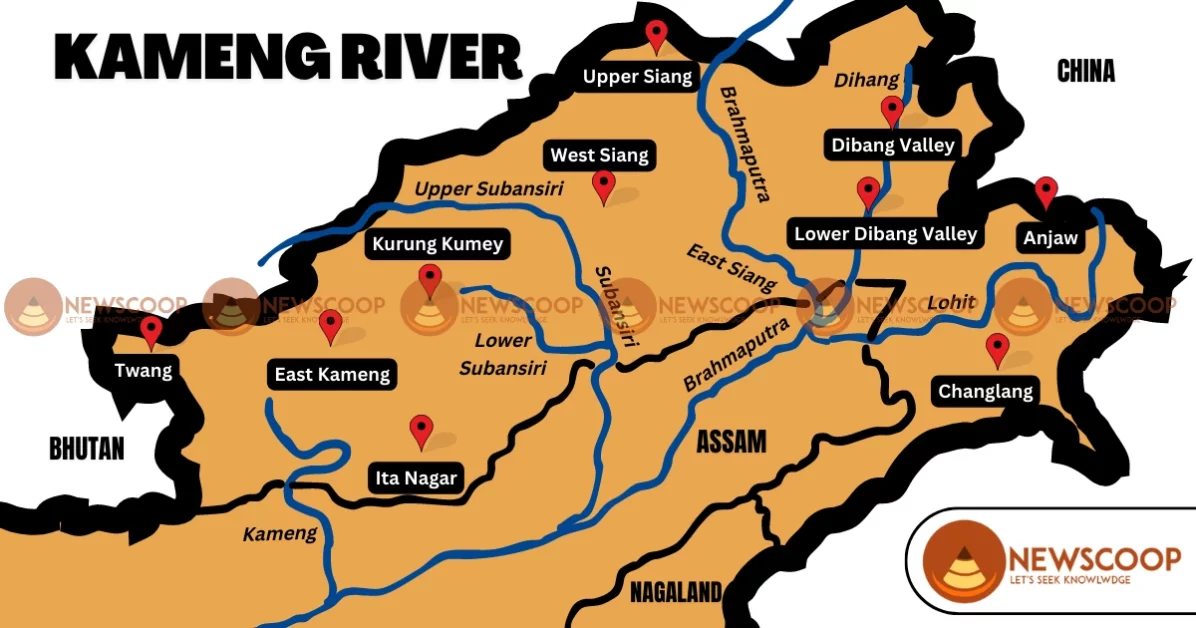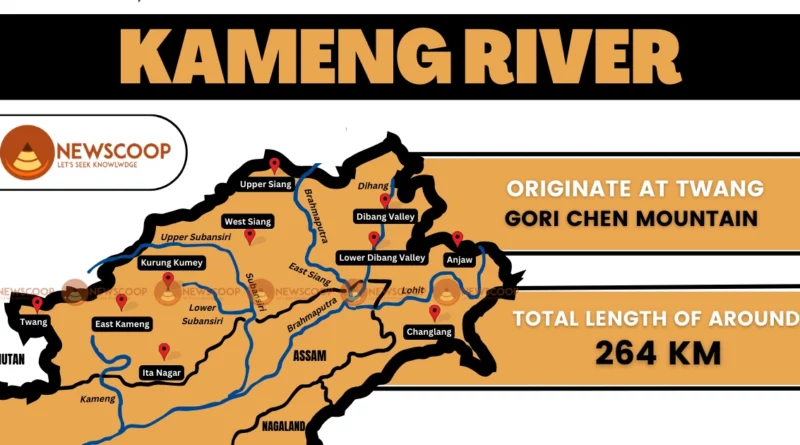Kameng River of Arunachal Pradesh with Map
The Kameng River, also known as the Jia Bharali River, flows through the beautiful landscapes of Arunachal Pradesh in northeastern India. This river is important because of its ecological and cultural value. If you are preparing for the UPSC exam, studying the Kameng River will give you insights into its geography, biodiversity, and the traditions of the local communities. Let’s explore this amazing river of Arunachal Pradesh together.
Geographical Features of Kameng River
The geographical features of the Kameng River encompass its origin, course, boundaries, and surrounding hills. Understanding these aspects provides a comprehensive overview of the river’s significance in the region’s geography and ecosystems.
- The Kameng River (previously known as the Bharali River) originates in the Tawang district from a glacial lake below Gori Chen mountain.
- It flows through the Bhalukpong circle of West Kameng District, Arunachal Pradesh, and Sonitpur District, Assam.
- has a total length of approximately 264 kilometers.
- It becomes a braided river in its lower reaches and is a major tributary of the Brahmaputra River.
- The river forms the boundary between East Kameng District and West Kameng Districts.
- The Dafla Hills are to the east, and the Aka Hills (home of Aka tribe) are to the west of the river.
- It is not a transboundary river.
- The main tributaries of the Kameng River include Tippi, Tenga, Bichom, and Dirang Chu.
Origin and Course of Kameng River
Kameng River originates from the eastern Himalayan mountains, previously known as the Bharali River, and begins its journey in the Tawang district of Arunachal Pradesh. It emerges from a glacial lake nestled below the majestic Gori Chen mountain.
From its origin, the Kameng River flows through the Bhalukpong circle of the West Kameng District in Arunachal Pradesh and the Sonitpur District in Assam. As it progresses towards its lower reaches, the river transforms into a braided river with multiple channels. Eventually, it merges with the Brahmaputra River near Tezpur, just east of the Kolia Bhomora Setu bridge.
Map of Kameng River

Tributaries of the Kameng River
Here are some of the main tributaries of the Kameng River:
- Tippi River
- Tenga River
- Bichom River
- Dirang Chu
Tribes Around Kameng River
The Kameng River region in Arunachal Pradesh is home to various indigenous tribes. Here is a list of some tribes found in the area:
- Monpa
- Aka (Hrusso)
- Sherdukpen
- Nyishi
- Adi (Galo)
- Tagin
- Miji
- Bugun
- Puroik (Sulung)
- Hill Miri
Hydropower Potential
The Kameng River’s fast-flowing waters present immense potential for hydropower generation. Several hydroelectric projects, including the 600 MW Kameng Hydroelectric Project and the 800 MW Tawang Hydroelectric Project, have been planned and are in progress along the river.
The harnessing of these water resources not only contributes to India’s energy needs but also poses challenges in terms of environmental impact and the displacement of local communities. It becomes imperative to strike a balance between development and conservation to ensure sustainable utilization of resources.
Ecological Wealth
The Kameng River is renowned for its rich biodiversity and pristine ecosystem. The river basin boasts a diverse range of flora and fauna, making it an ecological hotspot. The region is home to numerous endangered species, including the Bengal tiger, Asian elephant, clouded leopard, and the vulnerable Indian giant squirrel.
The river’s flow sustains lush forests, supporting a wide variety of plant species, including orchids, ferns, and medicinal herbs. The Kameng River’s ecosystem exemplifies the fragile balance of nature that must be preserved for future generations.
Conclusion
The Kameng River, with its captivating landscapes, thriving biodiversity, and deep-rooted cultural significance, offers an enriching topic for UPSC aspirants. Understanding the geographical, ecological, and cultural aspects of this magnificent river in Arunachal Pradesh is crucial for comprehending the broader dynamics of the region.
As the world grapples with environmental concerns and the need for sustainable development, the Kameng River stands as a testament to the delicate balance that must be maintained. Exploring this topic will undoubtedly broaden one’s understanding of India’s diverse natural and cultural heritage.
Thank You!

